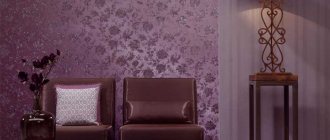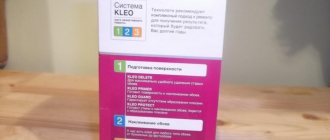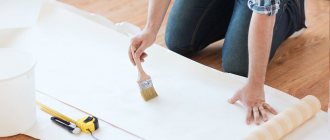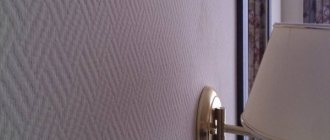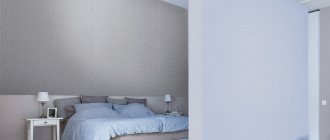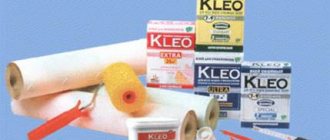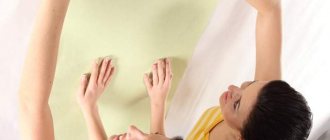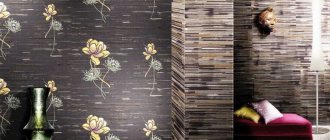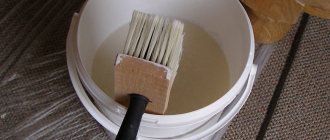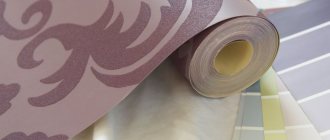How to dilute wallpaper glue correctly
If you are planning a renovation, then, as a rule, one of your tasks will be to re-glue the wallpaper. This process, although not incredibly complicated, still has an abundance of nuances and subtleties. It is necessary to understand the principle of each stage of gluing, starting from diluting the glue and ending with leveling the already pasted surface.
The process of preparing the adhesive solution
Let's start with the first one, looking at how to dilute any wallpaper glue, no matter for paper, non-woven, vinyl or any other wallpaper. This step seems simple, but it's not entirely true.
What you will need
To dilute the glue you will need items that can be found in every apartment. If suddenly they are not there, then you can buy them at any hardware store. It is imperative to work only with clean objects, because any contamination can affect the quality of the final glue.
To make the job easier, it is recommended to use a suitable tool
Here's what you'll need to thin out the wallpaper glue:
- Wallpaper glue. It would be strange to do without him. It is important to carefully select the required glue, more on this later. It should be suitable for the wallpaper that you intend to glue.
- Capacity. A bucket or basin is ideal. Take a large enough container, because otherwise, when mixing, the glue will splash and spill in every possible way.
- Water. It is important to understand what kind of water you need to dilute wallpaper glue. In principle, it can be anything, but it is best to take clean water that does not contain sand impurities. Its temperature should be approximately room temperature, about 25 degrees, then the glue is most likely to come out without lumps. You can increase the temperature, but then it is better to stir using something relatively powerful, for example, a mixer.
- Stirring device. There can be many options here. Someone stirs with an ordinary stick - this option also has a right to exist. Some people use construction mixers, while others adapt regular kitchen mixers. The latter may not be inferior in the quality of stirring, but only in terms of accuracy they are noticeably worse. Another option is a drill with a special mixing attachment installed.
Glue selection
Before you directly dilute the glue, you need to select it correctly. The adhesive composition is selected based on what type of wallpaper is available.
For example, almost any one is suitable for paper ones, but, for example, non-woven or vinyl ones require a stronger and thicker glue.
So if you choose glue for vinyl, non-woven or other similar wallpaper, be sure to refer to the instructions that traditionally come with this glue. If you are not sure, take proven brands of glue Kelid, Pufas.
Every self-respecting manufacturer offers a wide range of wallpaper glue
The principle of diluting glue
Now let's take a look at how the glue is diluted. It is necessary to follow the sequence of actions and act correctly at each stage.
- First, you need to pour water into the container that you previously prepared and washed. The temperature, as indicated above, can be 25 degrees, but it will be quite comfortable even if you raise it to 40 degrees, preferably not higher.
- We take the package of glue and study it. This package will indicate the required proportions that you need to use. You estimate how much water you have poured, then estimate exactly how much glue you will need to add for this amount of water. If you overdo it, the mixture will be too thick and may not even dissolve properly. If, on the contrary, you do not add enough, then everything will be very liquid. In the latter case, the glue may not hold the wallpaper properly, especially if it is heavy, like non-woven wallpaper, so this should be avoided.
- You pour the glue into the water little by little, stirring constantly. It is very important to pour little by little, no matter whether your glue is released in granule or powder form. If you still do not follow all this, then everything will come together in clumps, as a result of which it will simply be impossible to use your glue.
- You can stir with anything, a number of optimal tools were given above, but the main thing here is how to stir. This must be done very carefully. Stir long enough until your solution has an acceptable consistency. You will know it is actually ready when it becomes smooth and transparent. It is worth making a reservation - the fact that it is transparent does not mean that it is colorless. It can easily have some shade, for example, pinkish and so on. Usually this shade is made to make it more convenient to apply glue to pieces of wallpaper - you can immediately see where everything is well coated, and where you missed some individual fragments and need to go a little more.
These are the stirrers that ordinary people use
- Although it was previously stated that the proportions specified by the manufacturer should be strictly maintained, in fact it is better to slightly reduce the proportion of water, by about ten percent. Sometimes manufacturers slightly overestimate the characteristics of their glue, indicating that it is much stronger than it actually is. By making the glue a little thicker, you increase its strength. The main thing is not to overdo it.
- After diluting the glue, it is extremely necessary to let it sit, usually about five minutes or a little more.
- If you dilute the glue to prime the walls, then dilute it to a consistency that is similar to kefir.
Now you have a complete understanding of how to make the right adhesive composition.
What types of wallpaper adhesives are there?
Today, the construction market offers many varieties of wallpaper - from the usual and inexpensive paper to expensive fabric. To get the optimal effect, you should use a specially recommended adhesive for a specific type of wallpaper. What are the different adhesive compositions?
First of all, all wallpaper can be divided into two categories: heavy and light. Moreover, only paper wallpapers belong to the second category - non-woven, vinyl, fabric and others make up the heavy variety. Let's figure out what specialized adhesive compositions are.
Only light paper-based wallpapers are relatively “indifferent” to the adhesive composition. Most often, the glue for them is made from PVA; there are brands with natural ingredients in the form of starch.
Vinyl wallpaper is heavier in weight. Therefore, it is better not to use light types of glue for them - the composition may simply not withstand the weight of the wallpaper. In addition, when gluing vinyl sheeting, it requires quite a long time to level it, smoothing out air bubbles and achieving the ideal location of the wallpaper.
Vinyl wallpaper glue takes a long time to dry, so at first the canvas can be moved freely along the wall. Vinyl glue may contain either PVA, methylcellulose or a modified starch mixture - however, it differs from “paper” glue in consistency and setting speed.
Non-woven
Non-woven wallpaper is also a material that is demanding on glue. First of all, the non-woven fabric is quite thin, so the adhesive mixture must be colorless, otherwise unsightly spots will remain on the surface of the wallpaper after drying. Non-woven wallpaper is often used for subsequent painting - accordingly, the glue should not react chemically with the paint. The basis of non-woven adhesive is modified starch - it is this that provides the required adhesion strength, is used sparingly and does not leave any marks on the wallpaper.
Dispersive
The heaviest types of wallpaper are fabric and glass sheets - for them it is customary to use dispersion adhesive based on water, acrylic and latex components. In terms of strength, it is the undisputed leader among other mixtures; in addition, it tolerates conditions of high humidity well. As a rule, the dispersion mixture is sold already diluted.
Universal
It is also necessary to mention the so-called “universal” wallpaper glue. From the name it is clear that this mixture is suitable for gluing any type of wallpaper - it contains synthetic additives and impurities, so it holds both light paper sheets and heavy fabric equally well.
Vinyl wallpaper on paper basis
Glue for paper-based vinyl wallpaper must be diluted with water in a ratio of 1:55 and coat all surfaces with the resulting mixture, then the wallpaper will stick firmly. This primer takes a day to dry. Vinyl wallpaper on a paper base is glued end-to-end, so you can start gluing from any place; in any case, the seams will not be noticeable.
The main condition is to draw a straight vertical line with a plumb line from where the gluing will take place. Apply glue to the first canvas and fold it with the coated side for impregnation. Then they smear the wall, apply the second piece of wallpaper and set it aside. The first canvas is glued to the prepared wall, aligned with the vertical line. It is necessary to smooth it over the wall without pressing hard, since the wallpaper stretches when wet and will shrink when drying.
What kind of glue will you need?
For paper-based vinyl wallpaper, paper wallpaper adhesive is suitable, for example universal, vinyl, super express. These adhesives can glue all types of vinyl wallpaper. In this case, the basic rule is to increase the amount of glue in the mixture. If the wallpaper is heavy, more glue will go into the water, so the mixture should be thicker.
Knowing how to glue vinyl wallpaper, what kind of glue to use and other nuances, you can create an interesting interior for your apartment quickly and easily.
Leading wallpaper glue manufacturers
Wallpaper adhesives are available in many brands. But there are several manufacturers that are especially popular:
- KLEO is a French brand that produces all major types of wallpaper adhesives on a natural basis made from modified starch.
- Metylan is a German manufacturer known for its wide range of adhesives and high quality.
- Moment is a Russian brand that covers all types of wallpaper adhesives. Modified starch and methylcellulose are used as the basis for Moment glue.
- Quelyd is another French brand that produces natural and high-quality glue for all types of wallpaper. It is especially often used when gluing non-woven fabrics; it leaves no marks and mixes well.
Adhesive mixtures from different manufacturers may differ in composition. However, in almost all modifications, in addition to the glue itself, there is also a bactericidal component. It protects the wall surface under the wallpaper from mold and mildew.
Product advantages
The main advantages of wallpaper glue are ensuring excellent adhesion of wallpaper to the wall, cost-effectiveness and safety. The cellulose included in the product has a positive effect on the price of the finished material, which is produced in packages of various sizes.
Consumption
Quelyd wallpaper adhesives are economical. A 250-gram package of product for vinyl or non-woven wallpaper is enough to paste 6-7 rolls of wallpaper of different types. This is approximately 25-35 sq. m. The consumption of adhesive composition for fiberglass sheets is slightly higher. To cover a surface of 35 square meters. m, you will need half a kilogram of dry matter. The exact consumption is indicated in the product description.
Manifold
There are several types of adhesive mixtures available on the building materials market:
- “Express”, intended for paper wallpaper and light canvases.
- “Super-express” with an improved composition, for paper and fabric wallpaper.
- "Kelid" "Glass wallpaper" is intended for all types of fiberglass wallpaper.
- “Special non-woven fabric” for gluing non-woven fabrics for subsequent painting, regardless of the room being decorated. Used in the kitchen, bathroom, bedroom, living room.
- “Special vinyl” for vinyl and fabric wallpaper, silk-screen printing.
On a note! In addition to wallpaper glue, in stores you can also find special Quelyd mixtures for cleaning walls and a product that acts as an indicator. It is applied to a wall covered with an adhesive mixture to find out whether the substance is evenly distributed over the surface. After all, the final result of the finishing depends on this.
Safety
Ready-made dry mixtures are tested to ensure that the products are not harmful to humans, animals and the environment. Strict control ensures high quality of Kelid adhesive mixtures, regardless of the type of composition.
Quality
Quelyd perfectly glues any wallpaper, and within 15-20 minutes after pasting it allows the canvas to move for the purpose of adjustment. The glue ensures easy joining of wallpaper canvases of any type and copes with gluing the material in hard-to-reach places. A quality certificate is provided for any mixture.
How to dilute wallpaper glue correctly?
Most wallpaper adhesives based on starch and methylcellulose are sold as a dry mixture. What to mix with and how to dilute this mixture?
- To prepare any glue you will need a spacious basin or bucket, a sufficient amount of water and the dry mixture itself. In addition, prepare in advance the object with which you will stir the glue - it can be an ordinary stick or a construction mixer.
- Read the instructions on the package - it will indicate in what ratio to mix dry powder with water.
- First, water is poured into the container, then glue is poured. It is recommended to take slightly warm water - about 25ºС. It is better if, when adding glue, you simultaneously stir the water in a circle - this way the mixture will be better distributed in the container.
- Having poured the required amount of solution, mix the glue for another 5 - 10 minutes - until you are sure that there are almost no lumps left in the finished mixture. After this, leave the glue to stand for about half an hour.
What glue consistency is considered optimal? It depends on the type of wallpaper, but in general, liquid compositions are only suitable for gluing paper sheets. For vinyl, non-woven and especially fabric wallpapers, it is recommended to use thick glue applied to the wall in a dense layer.
If you are not sure that you can achieve the desired consistency of glue the first time, try to make the mixture too thin rather than too thick. Gently diluting the mixture with water is much easier than pouring additional glue into the container.
Cooking algorithm
Wallpaper glue is produced today in the form of peculiar flakes, which, when mixed with water, swell and form a mixture similar to a gel or jelly.
The glue preparation technology consists of the following sequential steps:
- First of all, you need to measure the required amount of clean water. Sometimes experts recommend using a slightly warm liquid, since the mixture can dissolve better in it.
- Afterwards, the required volume of solution is measured. To do this, it is advisable to use a measuring cup to maintain all proportions.
- Before diluting the glue with water, it is advisable to use a stick to make rotational movements to force the liquid to move in one direction. After this, small portions of the flakes are poured into the container. It is important to constantly rotate the stick to prevent the glue from sticking.
- When the flakes have all dissolved and a gel has begun to form, you can finish stirring the mixture. After this, it is left for 5-15 minutes. This is necessary so that the remaining components can swell and acquire the desired consistency.
Once preparation is complete, you can apply the solution to the wallpaper or wall. Please note that it is not advisable to store the mixture for a long time, as it will lose its properties. Therefore, try to calculate as accurately as possible the required amount of the required volume of adhesive.
Rules for applying wallpaper glue
So, you purchased wallpaper, selected the appropriate glue and diluted it in a bucket according to all the rules. Now it's time to start applying it.
- To apply wallpaper glue, it is recommended to use a special wide brush or wallpaper roller. With their help, you can apply the glue as evenly and quickly as possible.
- If you apply glue to the wallpaper itself, then you need to coat the canvas from the center to the edges. If only a wall is being processed, or a wall and a piece of wallpaper at the same time, then glue is applied to exactly the area that is directly intended for gluing.
Is it better to apply glue to the wallpaper, to the wall, or should we treat both the surface and the wallpaper? This again depends on the type of wallpaper.
For example, paper webs require direct treatment with glue - they need to be saturated with the adhesive composition and slightly swollen. If you glue dry paper wallpaper to a wall coated with glue, it will swell during the drying process - and accordingly, it will wrinkle and bubble.
But in the case of vinyl, non-woven and fabric canvases, most often only the wall is processed. The glue is applied to it in a dense, even layer, and the canvas is simply applied on top and pressed. To find out how best to stick the wallpaper you bought, it’s worth studying the packaging - usually the manufacturer makes a special marking in the form of a brush directed “towards the wall” or “towards the wallpaper”.
After gluing any wallpaper, the wall should be carefully smoothed with a cloth or soft roller. This way you will prevent the appearance of bubbles, and at the same time collect excess glue that will inevitably appear at the joints.
Drying times for adhesives can vary widely. Typically, glue for paper wallpaper dries from a day to three, for vinyl wallpaper - about two days, for non-woven wallpaper - a day or two. But the drying speed of the glue directly depends on the room temperature. By the way, it is not recommended to artificially increase the temperature, much less ventilate the room - this will negatively affect the quality of work.
How much does diluted glue cost?
Although diluting the dry mixture before wallpapering is not the most difficult task, many are afraid of making a mistake or simply do not want to spend time preparing the mixture . In this case, you can immediately purchase ready-made glue - most manufacturers, and in particular KLEO, Quelyd, Metylan, offer customers diluted modifications.
How much does ready-made glue cost? As a rule, its cost is about 3 times higher than the price of the dry mixture. If a regular adhesive mixture in powder form costs about 300 rubles, then ready-made glue will cost 900 rubles or more. However, for this money you will receive high-quality glue of ideal consistency, ready for use.
How to choose an adhesive composition?
Currently, the Russian market offers a huge selection of glue for any type of wallpaper. And this is no coincidence, since manufacturers of adhesive compositions take into account the wallpaper material, its features and application technique. This must be taken into account when choosing an adhesive composition for wallpaper.
An incorrectly selected adhesive can ruin all your work, for example, the wallpaper will, at best, peel off or not stick to the wall at all. Therefore, it is always necessary to remember that for heavy vinyl wallpaper it is better to choose a special adhesive composition suitable specifically for this type of coating.
When buying glue, first of all, make sure that its label says: “for vinyl wallpaper” or “for heavy wallpaper.” This material is ideal for paper-based and non-woven wallpaper.
This glue is always based on modified starch and various additives that can not only enhance the adhesive properties of starch, but also protect walls and coatings from fungi, mold and insects
Often, the adhesive composition has high sliding properties, which allow you to adjust and align the canvas directly on the wall, which is very important when working with vinyl covering, especially on non-woven material, since it is much heavier than the paper base
Some manufacturers produce adhesive mixtures with a pink or blue indicator. Don't worry in advance, these colors become transparent as they dry. Such an indicator is needed so that the glue is clearly visible on the wall or wallpaper, so as not to accidentally miss an uncoated area. Otherwise, the wallpaper simply won’t stick, and the work will have to be done again.
If you will use borders (made of paper, fabric, vinyl) as decorative elements, applying them both to wallpaper and to walls, then in this case you also need to choose the right adhesive. For these purposes, you will need a special border adhesive. It is produced by various manufacturers, some even, for convenience, supply the jars with a brush or spatula, with which it is convenient to apply the mixture to the coating.
How to glue problem areas and seams?
Any canvas tends to peel off at the seams and in problem areas - in corners, near windows, under the ceiling. Defects can appear both immediately after drying and a long time after gluing. How to deal with this problem?
Most often, the peeling area is glued with ordinary wallpaper glue left over after the repair. However, if the defect cannot be eliminated, you can use special strong formulations from well-known brands. For example, there is adhesive for joints and wallpaper gluing KLEO Strong, as well as reinforced compounds from Metylan and Quelyd.
Adhesive mixtures are most often produced in tubes - this allows you to quickly apply a small amount of glue to the problem area. Such mixtures contain additional reinforcing additives - so the treated seam will hold tightly and will not require new sizing for a long time.
Glue "Moment" for wallpaper
“Moment” wallpaper adhesive is produced by the German company, the same company that produces “Metylan” and “Ekon” wallpaper adhesives, as well as adhesives for other purposes (seconds, epoxy, shoe, sealants). The wallpaper adhesive series includes 4 varieties:
- Classic - for paper wallpaper,
- Vinyl - for all types of vinyl wallpaper,
- Non-woven fabric - for wallpaper on a non-woven basis,
- Extra - for heavy, structured, special types of wallpaper.
It also produces a primer for preparing the surface for gluing with a decorative coating and a special adhesive for joints.
The basis of all Moment brand adhesives is carboxymethyl ether of potato starch (modified potato starch) and components that prevent the appearance of fungus. Antifungal additives are especially important for wall coverings made of artificial materials, which do not allow the wall to “breathe.” Varieties designed for vinyl, non-woven and heavy wallpaper also contain methylcellulose, which increases adhesion - thanks to it, heavy wallpaper will stick more firmly to the wall.
Choice of material: what glue to use for vinyl wallpaper on non-woven backing
Having decided to stick vinyl wallpaper on non-woven fabric, you can be sure of the right choice, since it is a beautiful, high-quality finishing material. Foam material is a modern innovation. Thanks to it, you can achieve a perfect renovation; even a beginner in this matter can hang wallpaper. Vinyl wallpaper can be on paper or non-woven backing.
The repairman must know what kind of glue is needed for gluing. If you choose the wrong glue, you won’t get a good result, there will be a defect, since the technology is broken
The pack of glue should indicate that the composition is suitable specifically for non-woven vinyl; it is important to look at the markings on the roll
Rules for gluing
- Apply glue only to the surface of the wall and in the corners.
- The walls must be coated very carefully; there should not be a single dry island.
- The glue must be diluted to normal thickness; it should not be very liquid.
If you choose the right glue, then gluing will be quick and easy, and the repair will delight you for many years, the wallpaper will not come off, will not swell, or peel off. Yes, if after the sticker the walls become visible, you shouldn’t be afraid of it, because as soon as the glue dries, this effect will disappear. The wallpaper dries quickly, literally 12 hours.
Specifications
In dry form, the glue appears as flakes or granules from white to cream color; in the version with an indicator there are pink inclusions. The solution has the appearance of a viscous homogeneous mass without lumps and odor, which is easily applied to the surface, “Vinyl with Indicator” is the same mass, but pink, losing color during drying.
"Moment Classic"
The adhesive contains modified starch (potato starch carboxymethyl ether) and antifungal additives. It can be stored for 2 years.
To prepare the glue, dissolve it in water, after 3 minutes you can start gluing. The pH of the finished solution is 9-11.5. The adhesive composition does not lose its properties for up to 14 days when stored at room temperature in a closed container. Consumption per 1 sq.m - 150-250 ml (in a standard roll about 5 sq.m).
For pre-treatment of the surface, glue is diluted in a ratio of 1:55 (11 liters of water per 200 g pack), for gluing - 1:35 (7 liters per 200 g) for light paper, 1:30 (6 liters per 200 g) for ordinary ones. paper, corrugated, embossed, washable, duplex, 1:25 (5 l per 200 g) for heavy paper, fibrous, foam wallpaper.
Is it worth using PVA?
Peculiarities
PVA (polyvinyl acetate glue) is an aqueous dispersion, i.e.
undissolved polymer particles in an aqueous environment. When drying, when the water evaporates, the polymers form a film that is no longer soluble in water. Is it possible to glue wallpaper with PVA glue and still get a high-quality result? Of course you can, as I said above, in the past this is how trellises were most often glued. However, it should be borne in mind that this adhesive composition contains both advantages and disadvantages. Therefore, it should not be considered as an alternative to wallpaper glue.
Polyvinyl acetate dispersion ensures reliable adhesion of trellises to walls
Advantages. The material has the following positive qualities:
- Good adhesion. Provides high-quality adhesion of the canvas to the base;
- Moisture resistant. Even in a damp room, the canvas will not peel off, since the formed film does not dissolve in water;
- Environmentally friendly. There are no harmful substances in the composition, so you can use it even in children's rooms;
- Strengthens the base . Capable of gluing loose substrates;
- Low cost . It is cheaper than wallpaper mixtures;
- Can be used for heavy wallpaper . It holds vinyl sheets and even glass wallpaper perfectly.
If you decide to use PVA to glue the trellises, do not forget to dilute it with water to increase fluidity. Otherwise, it will not be possible to apply the liquid in an even, thin layer. Otherwise, the instructions for gluing wallpaper are the same as when using regular wallpaper glue.
Before use, polymer glue must be diluted with water to obtain a liquid consistency.
Flaws:
- Difficulty in removing old wallpaper . As a result of good adhesion, old trellises are very difficult to remove. Moreover, water in this case, as you remember, does not help;
- Doesn't glide well . Therefore, it is quite difficult to join the patterns of the canvases with each other with your own hands;
- May bleed through paper . If the trellises are paper and thin, liquid may leak through them. As a result, yellowish spots will appear on the surface;
- Dries for a long time and unevenly . Therefore, it is necessary to maintain suitable conditions in the room for the wallpaper to dry for a long time. At the same time, it sets quite quickly, which makes gluing somewhat more difficult.
Polymer adhesive makes it difficult to remove old trellises
Beginners are often interested in how to remove wallpaper glued to PVA? You can soak the top layer of wallpaper and then remove it along with the glue using a scraper or chisel. When the wallpaper is removed, you will have to clean the wall mechanically or using a hair dryer and a spatula.
From this we can conclude that it makes no sense to use a polyvinyl acetate mixture for gluing trellises, because at present there are many inexpensive and high-quality wallpaper adhesives. However, you shouldn’t completely abandon it either - below we’ll look at in what cases it may come in handy.
Polymer film allows you to strengthen the surface of the walls
When can you use PVA?
The adhesive composition in question can be successfully used in the following cases:
- For priming loose surfaces . If, for example, you are going to glue trellises onto old plaster, this material will strengthen the base. The only thing is that it should not be used in its pure form, but diluted with water in a ratio of 1:2 to obtain a liquid, well-penetrating consistency;
- For gluing edges . You can successfully glue the wallpaper with PVA glue if it has peeled off at the edges. Since it has good adhesion to almost any surface, surfaces previously treated with wallpaper glue are also not a problem for it;
- For adding to wallpaper paste . A small amount of this composition will improve the adhesion of wallpaper glue, while maintaining all its other qualities. As a rule, it is added in a ratio of 1:20;
Choosing the best glue for non-woven wallpaper
Non-woven wallpaper is popular both among craftsmen who professionally carry out finishing work, and among people who decide to carry out repairs on their own. The choice is not accidental, because such a base is much stronger than ordinary paper. In order for the finish to lie smoothly, it is recommended to choose only high-quality adhesive composition. Before choosing the best adhesive for non-woven wallpaper, you need to familiarize yourself with the list of popular brands, as well as learn more about the properties of the substance.
Manufacturers
Currently, the building materials market is overflowing with offers for wallpaper glue. There are Russian, German, French, Italian, English and even Swedish manufacturers here. We will give some recommendations regarding the most famous and popular brands.
Quelyd
French Kelid adhesive for non-woven wallpaper is called “Spets-Flizelin” and “Flizelin Aqua”. It is packaged in a large box, which is approximately enough for three meter rolls. If you have vinyl wallpaper with a heavy, bulky pattern, which greatly increases the weight of the wallpaper, then this glue will help you glue it to the wall efficiently.
French composition for working with heavy wallpaper
Kleo
Another worthy French company that produces good wallpaper glue. Rumor has it that the plant of this company and the Kelid company are located on opposite sides of the same street. Isn’t this a coincidence, since there is little difference in the quality of the glue. For non-woven base we choose Kleo Extra or Ultra
Please note that the glue consumption is indicated on the pack, but you should take a little more, because it is unknown how your walls will absorb the liquid
Metylan
Widely advertised wallpaper glue made in Germany. The glue is certainly of excellent quality, but its cost is high. However, the Henkel company, which produces this wallpaper paste, owns several other worthy brands. If you decide to choose German quality, then Econ and Moment wallpaper adhesives are also suitable for you.
The most famous wallpaper glue of recent years
Vinyl wallpaper on a non-woven basis can be glued to:
- Econ is extra strong;
- Moment Interlining;
- Metylan Non-woven Ultra Premium.
By and large, all these adhesives have a similar composition, only the price differs.
Quality
Despite the foreign name, Quality is a Russian company engaged in the production of various chemical products. Wallpaper adhesives of this brand are distinguished by their low price and acceptable quality.
Glue in a bag from a Russian manufacturer
However, for our version this glue is still rather weak, but if you want to try it, buy Quality non-woven glue. Recently it has been packaged in a blue bag.
Exclusive
English glue manufacturers are represented by the Exclusive brand. For our heavy wallpaper we choose Exclusive non-woven wallpaper. Non-woven wallpaper adheres well to this composition, but it is most often used by professionals. Amateurs somehow had no luck with this glue, as evidenced by reviews on the Internet.
https://youtube.com/watch?v=cLxhg6BqdGA
As you can see, there is plenty to choose from. When buying vinyl wallpaper, check whether it has a non-woven base, and if so, choose any of the above wallpaper adhesives.
Characteristics of wallpaper glue on non-woven fabric
As you know, wallpaper is the face of the room, which is why an important role is played by how and with what composition they will be glued. Wallpaper adhesive for non-woven wallpaper has certain properties that make it applicable specifically to this type of finishing material:
- fast setting of glue;
- ease of application to walls;
- lack of reaction when interacting with paint or other substances;
The best adhesive for non-woven wallpaper should be of high quality and not leave stains on the wallpaper when applied. In addition, the consumption of the substance must be economical.
A properly prepared composition for wallpapering should not contain lumps and be too liquid. The consistency of the best non-woven wallpaper glue should not be too thin and watery, so it is important to maintain the proportions when mixing the solution. When the glue is applied to the walls, it does not flow down or clump together, but, on the contrary, is evenly distributed over the entire panel using a wide brush.
After diluting the solution, good wallpaper glue should sit for about 10 minutes. When the work is completed and there is still glue left, it can be stored in a closed container for 10 days.
Let's start cooking
Having prepared everything you need to prepare the solution, you can safely begin preparing it.
First of all, study the instructions for use, which are written on the back of the composition you purchased. Do not delay reading the instructions or not read them at all. If you do not do this, it may turn out that the solution simply does not work out and you will need to buy a new pack.
Let's get started:
- To begin with, you should pour water into the container that you have prepared. How much water you need to pour depends on what is indicated on the packaging of the purchased glue. For a more accurate measurement of water, a measuring container is better suited; thanks to such a container, you will definitely pour as much water as you need. Important! Initially, water is poured into the container, and only then glue is poured.
- Next, stir the water with a stick to make a funnel and gradually pour glue into it. If you pour all the powder into water at once without stirring it, then when the glue interacts with water, large lumps will form and it will be quite difficult to break them. Most likely, you will need to buy another bag, and you will simply throw this one away.
- While you are falling asleep, put the powder into the water with one hand, and stir with the other hand, and this should be done intensively. It will be more effective if you do this with a stick or another object that you have prepared for stirring.
- After you pour out the mixture, do not stop and stir it for another 10 minutes, and only then leave it for 20 minutes. This is done in order to completely prepare the solution; as it swells, it acquires its abilities. In order to stick heavy wallpaper, you need to leave the composition for an hour, and only then you can safely use it.
Review of popular manufacturers
The choice of the best wallpaper glue for non-woven wallpaper always depends on the technical characteristics of the composition, which are indicated by the manufacturer on the packaging. The quality of the finish and the strength of the surface adhesive directly depend on the composition of the substance. In the table provided you can see the main manufacturers of glue for non-woven wallpaper, as well as their consumption and cost.
You should take a closer look at the adhesive for non-woven wallpaper from each manufacturer.
Glue Exclusive
The adhesive compositions of this manufacturer are made in England and are of high quality. In particular, for wallpaper with a non-woven base, ExclusiveNonWoven glue is suitable, which also glues paper, vinyl, textile wallpaper and silk-screen printing well. If the question arises: which wallpaper glue is best for luxury non-woven wallpaper, the answer will not be long in coming - choose Exclusive glue.
The advantages of Exclusive adhesive include ease of application and excellent slip properties, thanks to which wallpaper joints stick together perfectly. This composition is equipped with special antifungal additives and is also absolutely safe for humans.
Metylan glue
This adhesive is produced in Germany and, when used, is applied directly to the wall, like most other compounds for non-woven wallpaper. Metylan wallpaper adhesive can be used on lime and cemented wall surfaces.
For wallpaper with a non-woven base, Methylan Flizelin Ultra Premium adhesive is suitable, which can be purchased at almost any hardware store. Due to the presence of additional polymer additives in the composition, the glue sets very quickly. Among the products for other types of wallpaper from this manufacturer there is a color indication, but here it is not available.
Such wallpaper glue for non-woven wallpaper can be stored undiluted for 3 years from the date of production, and when diluting the adhesive solution, it is better to follow the instructions on the pack. According to the manufacturer, Methylane for non-woven wallpaper is ready within 5 minutes after mixing.
Quelyd glue
French-made adhesive compositions of the Kelid brand are characterized by their economical consumption. After complete drying, which occurs within 2 days, the kelid wallpaper glue becomes colorless. The presence of antibacterial properties in the composition allows this glue to be absolutely harmless to humans.
QuelydSpetsFlizelin adhesive is suitable for wallpaper of any width; thanks to its quick dilution, the speed of wall pasting increases significantly. In addition, the already mixed solution can be stored in a bucket for up to one week. The main storage condition is to protect the composition from frost.
Pufas glue
Adhesive from a German manufacturer for non-woven wallpaper Pufas Euro 3000 has a color indicator, which greatly helps during work. A blue indicator was added to the composition initially and helps control the amount of glue applied.
5 minutes after mixing, the solution is ready; thanks to this speed, this composition can be called the best adhesive for non-woven wallpaper, which is diluted in a matter of minutes.
Antiseptic additives in Pufas glue prevent the appearance of fungus and insects under the wallpaper. If you apply glue directly to the wallpaper, its consumption will decrease, and 7.5 liters of water will be needed to dilute one pack.
This glue is considered one of the best professional compounds for gluing non-woven wallpaper. The French manufacturer offers a whole line of KleoLine non-woven wallpaper products.
The main product is KleoExtra Non-woven Line Professional in a pack weighing 250 g, which will take 5 minutes to prepare.
Wallpaper glue for non-woven wallpaper kleo has antifungal additives, and the finished composition can be stored for 10 days. A very advantageous advantage of this glue is the ability to hide some wall defects.
What determines glue consumption?
It is recommended to purchase glue at the same time as wallpaper. The choice depends on the distinctive characteristics of the facing material. Specialists at a hardware store will definitely advise you on the issue. If you have information about the characteristics of wallpaper and strictly follow the technology for performing the work, glue consumption will be minimal. You don't have to make your own adjustments. It is important to strictly follow the manufacturer's recommendations.
In fact, the consumption of the fixative indicated on the packaging may vary depending on the specific conditions of its application. As the mass of wallpaper increases, a thicker composition is required.
A few recommendations from experts:
- priming the surface is performed not once, but twice. The fixative is not so absorbed into the base of the wall;
- use glue and wallpaper from the same manufacturer.
Important! The structure of the wall surface directly affects the consumption of the fixative. The smoother and more uniform the surface, the less composition is used.
Which glue is better (customer reviews)
According to reviews from customers who have used these types of glue, the following conclusions can be drawn:
- quelyd wallpaper adhesive for non-woven wallpaper is odorless, affordable, moisture-resistant, and easy to prepare. Consumers recommend it as a reliable and durable adhesive composition. The only downside is the lack of plastic packaging for the glue - it is packaged directly into cardboard;
- In terms of consistency and thickness, users prefer wallpaper glue for non-woven wallpaper kleo, which spreads well without forming lumps;
- Methylane glue is noted by consumers as an easy-to-use and quick-setting adhesive composition;
- The Pufas brand does not find proper approval among most interior decorators due to the formation of lumps and low adhesiveness;
- Consumers call the glue manufacturer Exclusive a good composition for gluing heavy wallpaper, but it has been noted that the glue leaves stains on light-colored wallpaper.
Range
The material of the French brand “Kelid” is represented by the following wallpaper compositions:
- paper;
- fabrics;
- vinyl;
- fiberglass;
- non-woven fabric
"Special interlining"
Wallpaper adhesive mixture, which is intended for non-woven wallpaper. These products are used both when decorating walls with vinyl canvases on a non-woven basis, and when gluing canvases for further painting of the surface. It is based on modified starch. The composition is non-toxic, contains bactericides and fungicides, and dries within 2 days.
On a note! The finished substance is applied to the wall. Non-woven canvas does not need to be treated with glue.
This composition is economical, like all Kelid brands. Consumption per 1 sq. m is only 10 g. A 250-gram pack of Quelyd “Special non-woven fabric” is enough to cover a surface of 25-35 square meters. m.
"Special Vinyl"
This is a natural vinyl-based composition. The adhesive mixture can be used for vinyl wallpaper, as well as embossed and paintable wallpaper, mica and granite wallpaper and other heavy canvases.
Suitable for bathrooms and kitchens, it grips well, but allows you to adjust the canvases after they have been glued. A package weighing 250 g is enough for 6 rolls of material. The shelf life of dry matter is unlimited.
Other types (glass wallpaper, paper, for joints and borders)
These compositions have good adhesive ability, are convenient to use and easy to prepare. Hermetically sealed, when prepared, they can be stored for more than a week. They are safe for the environment and people. You can buy them in dry and ready-made form.
What consistency should wallpaper glue be?
The choice of wallpaper glue is influenced by several factors - the thickness and type of wallpaper, wall surface, room temperature and humidity level. The glue is sold in two forms - ready-made emulsion and powder, which is diluted with water and left for half an hour. The adhesive contains: methylcellulose base, vinyl acetate polymer and bactericides to protect walls from fungus. Ideally, wallpaper adhesive is chosen after purchasing the wall covering, having previously calculated the consumption.
Content
The purpose is indicated on the packaging
Wallpaper adhesive of any type is prepared based on a general formula, including a base, a PVA additive and a fungicide with a bactericide. The base makes up half the mass of the powder, the PVA additive is another 45-50%, and the bactericidal components are 3%.
The base is a component that becomes viscous upon contact with water and has the ability to glue paper to any building material. The higher the viscosity of the base, the more firmly the wallpaper “sticks” to the walls. PVA –.
Wallpaper is the final stage of finishing a room, and here you need to approach every detail wisely. The quality of the finish depends on the prepared wallpaper glue. If you buy the wrong glue or if you don’t know how to dilute wallpaper glue, you will definitely not be happy with the results. In the best case, you spend much longer fiddling with the wallpaper, and in the worst case, the wallpaper will simply come off the wall, bubbles will appear, or the joints of the canvas will diverge.
What types of wallpaper glue are there?
Before we figure out how to dilute wallpaper glue, let’s find out what types of glue there are. It all depends on the type of wallpaper itself, which can be:
Accordingly, you need to take special glue. For non-woven wallpaper - non-woven glue, for paper - paper and so on. The adhesive contains starch or methylcellulose, as well as various impurities, for example, for obstruction.
Renovating an apartment or house is a process that any person has encountered at least once in their life. At one stage you have to deal with finishing the walls. Wallpaper is considered the most popular material for this purpose. There are many types of wall coverings, but the latest idea from experts is non-woven wallpaper.
Peculiarities
Non-woven wallpaper is presented to the consumer in two versions:
Pure non-woven wallpaper consists of several layers of non-woven base. At the same time, the lower layers are absolutely smooth, and the upper one is embossed; Non-woven wallpaper is non-woven wallpaper with a layer of foam vinyl or fabric applied to it.
In both cases, the wallpaper has a smooth non-woven coating on the side that is glued to the wall. This ensures a tighter fit and stronger adhesion of the canvas and the wall.
Regardless of the type of non-woven wallpaper you choose, you must remember the features of wall covering.
If you are planning a renovation, then, as a rule, one of your tasks will be to re-glue the wallpaper. This process, although not incredibly complicated, still has an abundance of nuances and subtleties. It is necessary to understand the principle of each stage of gluing, starting from diluting the glue and ending with leveling the already pasted surface.
The process of preparing the adhesive solution
Let's start with the first one, looking at how to dilute any wallpaper glue, no matter for paper, non-woven, vinyl or any other wallpaper. This step seems simple, but it's not entirely true.
What you will need
To dilute the glue you will need items that can be found in every apartment. If suddenly they are not there, then you can buy them at any hardware store. It is imperative to work only with clean objects, because any contamination can affect the quality of the final glue.
To simplify the work, it is recommended to use.
Wallpaper glue: all the nuances and subtleties of the right choice
The beauty and aesthetics of walls is largely determined by the quality of wallpaper, because even the most expensive types of wallpaper can easily be ruined by sloppy work - loose edges and peeling joints. To prevent this from happening, you should choose the right wallpaper glue. We will now look at how to prepare for one of the most important tasks during the entire repair and how to choose the right adhesive composition.
Which wallpaper glue to choose
Types of wallpaper adhesives
Before we move on to the choice of adhesives, let us remind you that on the shelves of construction stores and supermarkets you can find wallpaper with an adhesive composition already applied - it is applied to the inside of the canvas. Dry glue just needs to be soaked with water (paper-based wallpaper is immersed in water for 1 second, non-woven wallpaper needs to be kept in water longer - 1-2 minutes) and then glued as usual.
Wallpaper base
To hang wallpaper yourself quickly and efficiently, you will need information about the tools and equipment available in wall covering and adhesive stores. If you have calculated your strength and are ready to get to work, then you should stock up on:
quality materials; reliable tools; desire; information about the correct technology for wallpapering.
Violation of technology inevitably leads to the fact that the first sheet lies crookedly or the angle turns out to be sloppy, and you do not achieve the desired effect.
First of all, you need to know on what surface you can stick the wallpaper. After all, all the rooms in the house have different wall coverings: the hallway may have painted walls, the living room may have decorative plaster, and the bedroom may have been wallpapered 10 years ago.
Pasting of paper or textile, natural, vinyl, non-woven wallpaper should only be done on a clean, slightly rough base.
Materials for apartment renovation
The appearance and elegance of wall surfaces in most cases is determined by the quality of the wallpaper, since even elite types of trellises can simply be damaged by careless work - peeled seams and bristling edges. To avoid such problems, you need to choose wallpaper glue wisely. We will describe in our article how to prepare for such an important task as wallpapering and how to choose reliable glue.
Which wallpaper glue to choose?
Before you start choosing adhesive compositions, it is necessary to emphasize that in construction shopping centers you can find wallpaper that already has an adhesive surface - it is located on the back side of the roll. Dry glue only needs to be wetted with water (paper wallpaper is dipped in water for one second, non-woven wallpaper needs to be kept in the container for about two minutes longer) and then proceed according to the standard algorithm, carefully smoothing the canvas.
Facts from history
Video about wallpaper glue
The very first wallpapers were not made from paper at all, but from fabric, and they did not need glue, since they were simply nailed to the walls. But paper decor, which appeared at the end of the 18th century, was glued onto canvas, which was then hung on the walls. Such panels were ventilated on both sides and could be easily removed, replaced or cleaned.
The ancestor of wallpaper glue in the Soviet Union is paste. This sticky solution was prepared at home from water and starch. Many of us still remember this pale brew, from which the wallpaper became stained and fell off before it had time to stick.
In Germany, at the beginning of the last century, a discovery was made that radically changed the complex relationship between people and wallpaper. Scientists have developed a water-soluble composition containing cellulose polymers.
Is it possible to glue wallpaper with PVA glue?
When carrying out repairs, many are concerned about the durability of coatings and wallpaper is no exception. Very often a problem arises such as peeling of wallpaper in some places or at the joints. And you can often hear the opinion that gluing wallpaper with PVA glue is more reliable and in the future there will be no problems with the sheet coming off.
PVA glue is a mixture of polymers and water, which, when evaporated, allows the mass to harden. After the polymerization process, the glue is very difficult to remove from the surface, much less dissolve with water. This process formed the basis of the opinion about its strength and reliability, as well as the possibility of using it for wallpapering. It is precisely because of its strength properties that many try, at all costs, to add PVA to wallpaper glue or even glue wallpaper with pure PVA. But is it worth doing this, and what consequences can it lead to? This article will examine this situation in detail.
Characteristics of PVA glue that prevent it from being used for wallpaper
Polyvinyl acetate glue forms a very durable coating and allows materials to be firmly glued to each other. This is perhaps the only plus in pasting it.
But there are a lot of disadvantages, thanks to which it is better not to use this type for repairs using wallpaper:
- The composition is very thick, resulting in uneven drying of the treated surface. It is very difficult to level the canvases on the surface under such conditions. Even using high-quality PVA will not give the same result as using wallpaper, since the latter is distinguished by the fact that it glides very well, which helps to install the canvas on the wall as intended and necessary. Special particles are added to wallpaper glue, which give it this quality, allowing it to glue canvases with better quality.
- As mentioned earlier, PVA dries over a longer period of time and unevenly. If it is spread with a thin layer, it polymerizes quickly, but in a thick layer a film is formed inside, which does not allow water to evaporate from some parts of the layer, thereby taking a long time to dry some areas.
- The polyvinyl acetate composition is finely dispersed, so gluing wallpaper with it on rough surfaces is not convenient and simply impossible, since it does not fill voids. Wallpaper adhesive consists of many large cellulose fibers, which helps to stick the canvas even to an uneven surface.
- After the adhesive dries, it becomes like plastic and will firmly hold the previously pasted wallpaper. If you need to make repeated repairs, it will be almost impossible to remove such a coating.
Because of these qualities, the use of polyvinyl acetate in wallpapering is not recommended. But situations arise when this product is indispensable for repairs:
- Peeling off joints. The already finished coating, on which the joints have begun to peel off, can be lubricated with PVA and wait a few minutes, and then pressed together. After this, the joints will already be tightly glued. Advice! For easier application, polyvinyl acetate should be diluted in the following proportion: 2 parts glue to 1 part water.
- Pasting overly heavy coatings. Wallpaper glue cannot always cope with very heavy canvases, so for such repairs you can dilute a little PVA in the wallpaper and mix thoroughly. The usual portion is 150 ml per 1 liter of wallpaper paste. This additive will improve grip. There is also a special wallpaper glue for such canvases, but it is usually not cheap, and in order to save money, this method is also suitable.
Recommendations for pasting
You shouldn’t complicate the repair process by gluing wallpaper on PVA; it’s better to choose a suitable wallpaper composition. Now the construction market offers a huge number of different types of adhesive compositions for any wallpaper. They will cope with the pasting with a bang. The main thing is to read the instructions on the package and dilute the mixture as indicated there. Also, proper coating of the canvas, without leaving dry spots, and precise processing of the joints will help in better quality pasting. There is no need to stretch the canvas when gluing it.
If you add PVA to the adhesive composition, you can improve the quality of adhesion, but this is possible, as mentioned earlier, only for high-quality durable and heavy coatings. Paper products from such an additive may begin to turn yellow and become tougher. Those who have tried to correct a thin coating with this type of adhesive are well aware of this property. After 2–3 years, under conditions of changing temperatures, such stains reveal themselves and spoil the entire appearance of the home, forcing the owners to carry out repeated repairs.
Now manufacturers are offering a new composition - this is polyvinyl acetate “Wallpaper”, which combines the qualities of two adhesive compositions, so for heavy wallpaper you can use it if there is no opportunity or desire to experiment with additives. It has already proven itself well, but it is not necessary to stick with it; everyone here chooses what is closer and easier for them. And this composition costs more than wallpaper glue for this type of canvas.
Features of PVA glue
If the paper sheets were previously glued to wallpaper glue, then there are no problems with their further removal from the surface - just soak the coatings and they will come off easily. The canvases treated with polyvinyl acetate glue come away from the walls with great difficulty. Sometimes it takes a lot of effort and time to completely clean the surface. During scraping, you can easily damage the surface of the wall, which will lead to additional processing before gluing. And, if the surface on which the wallpaper is placed is made of plasterboard, then its damage is inevitable. Afterwards you will have to do puttying and leveling, which also takes time and money.
Regular wallpaper adhesive is cheaper than polyvinyl acetate, so you shouldn’t overpay and then suffer during the repair process.
Conclusion
There is no need to purchase PVA glue for wallpapering, since modern wallpaper adhesives do an excellent job of their function. Correct selection and strict adherence to the dilution and pasting technology will not give the canvases a chance to fall off the surface. In a joint separation situation, PVA can be used, but only for small areas.

